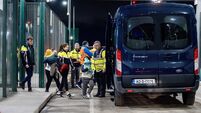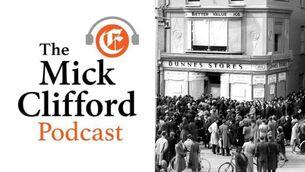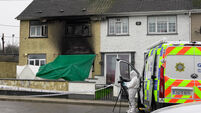Special report: The drugs trade in Ireland

IT MAKES for sobering reading.
A drugs trade more deeply entrenched than ever, where young people are increasingly the foot soldiers and where levels of violence have worsened.
A market that has seen prices actually fall and where the availability has remained effectively unchanged despite the massive efforts of gardaí and customs.
The message comes from a landmark piece of research — the first of its type in Ireland.
Given the study was commissioned by the State’s own d rug and health research bodies and the depth of work involved — conducted over three years — it is a message that cannot be ignored.
The research investigated and detailed Irish drug markets, including the structure of gangs and the impact of garda interventions.
It involved interviews with drug dealers at various levels and interviews with gardaí in local drug units at all levels in four areas in the country.
This was supplemented by street surveys of more than 800 people in those areas.
Interviews were conducted with members of the Garda National Drugs Unit and Customs and access was given to the Garda Pulse system for arrest and seizure data.
It conducted a detailed analysis of drug purity from the four areas with the Forensic Science Laboratory.
The research, conducted during 2008 and 2010, was commissioned by the National Advisory Committee on Drugs and Alcohol and the Health Research Board, both attached to the Department of Health.
It is unfortunate that publication of the report was held up for years as it struggled to get the green light from a number of departments, including justice.
Summarising the findings, lead author Johnny Connolly said: “Drug markets are more integrated in local communities. The markets are younger, more violent, there are more varied types of drugs with new novel psychoactive drugs, drug prices have fallen and drug use has been largely unaffected by law enforcement.”
Mr Connolly, a criminologist at the HRB, accepted it was “a grim picture”, despite progress in other areas, including treatment services.
“Despite widespread concern about the societal impact of illicit drug markets and related crime, there has been an almost total absence of in-depth research and analysis of the organisation and impact of illicit drug markets in Ireland,” he said.
“Although significant resources are invested in responding to drug-related crime and other harms associated with illicit drugs, we have only a limited understanding of the impact of such interventions.”
A number of issues were examined by Mr Connolly, and co-researcher Marie Donovan, in their 300-page report.
GNDU officers told the researchers how massive quantities are brought in.
“It would be a small group, it could be two or three people at the top level,” said one member. “These would be the people that may be in contact with people abroad. The top level. These would be the people that would be organising the price that they would be buying 100,000 pills or 30 kilos of cocaine. The next job of these people based here would be to ensure that it gets into the country without detection. The top level would be careful not go near the substances and they will have people around them that will move the drugs to a safe location.”
Another officer likened the structure to a “virtual company” with a core group surrounded by a larger group, of up to 20, who have specific functions, such as transport, storage, distribution, debt collection and money laundering.
Within the four areas studied, the authors found different market structures. In Site D, located in Dublin’s inner city, it was “highly structured” with three to four layers of distribution, including top suppliers, two middle layers with multiple gangs, where the drugs are diluted and bagged, and a street level. This site also had particular problems of open, visible markets.
In contrast, Site C, an urban area in another part of the country, the distribution of cocaine and cannabis was dominated by established families and transactions were mainly done through mobile phones.
In Site A, a satellite town of Dublin, young people played a “substantial role” as runners — storing and couriering drugs — and street sellers. It was a “lucrative option for teenagers” said the report, which heard from sellers and drug officers that children as young as nine were involved. When researchers examined PULSE records they found that a fifth of suspected supply offenders were aged 18 or younger. In Site D, young people were also “heavily involved in running drugs”.
All the street surveys highlighted drugs as being a big problem. This was compounded by underage drinking, property and vehicle damage, burnt out cars and intimidation. Many people reported avoiding areas.
The researchers said this “loss of communal space” and the “detachment” of people from where they live created a “sense of disempowerment” and a “cycle of alienation”. A major feature of these areas was how scared people were of local gangs.
“One reason communities won’t engage with gardaí is fear, they would feel it will come back on them and their families,” said Mr Connolly.
The research gives a rare, and balanced, insight into garda actions. It said that while both gardaí and customs have surpassed seizure targets laid down in the National Drugs Strategy 2012-2016, it was difficult to establish any relationship with availability.
While garda efforts can “contain” drug markets and “frustrate” their expansion, there was “no evidence” drug availability was affected significantly for any period.
“Gardaí acknowledged that, although their activities led to the disruption of the market, the impact was generally of short duration, as markets adopted quickly.”
The report does highlight the positive impact local garda activity has for communities. Their operations can provide them with “respite” and “relief” for a time.
Dealers have to keep “looking over their shoulder” and when high-profile arrests take place it can act as a “wake up call” to other, younger, dealers.
The report said police visibility “can increase resident confidence” in them and local people welcome communication from gardaí on their actions and successes.
Mr Connolly said greater garda presence was the one thing people wanted in each of the four areas surveyed.
But he told the Irish Examiner that gardaí were just part of the required response, which fundamentally must address the “socio-economic and environmental context”.
He said there needs to a fundamental rethink — one informed by research, analysis and strategy — as to what the State wanted to do and how it would do that.
He said not all drug markets were the same and emphasis should be on those which caused most harm — such as open crack markets and gangs using young people.
He said consideration should be given to using the adult cautioning scheme for certain drug possession cases.
Although he doesn’t offer an opinion on decriminalisation, Mr Connolly said it was a debate taking place internationally and was an “important one”.
Fundamentally, he said the strategy must start and finish with affected communities, with enhanced, formal cooperation by State agencies and a long term commitment to address problems.
“That community dimension is key: that’s where the problem hits first and hits hardest and where the most damage is done. The State has to find a way of engaging communities most affected and deal with their concerns.”
Suburban satellite town of Dublin, population 40,000. Problems identified in a street survey included drugs (90%), underage drinking (84%), vandalism (74%) burnt-out cars (54%) and intimidation (48%).
Rural site, including town of 2-3,000 and hinterland of 11,000. Near Dublin-to-Limerick train line. Problems: drugs (70%), underage drinking (69%), vandalism (39%) and intimidation (26%).
Urban site, population 30,000. Problems: underage drinking (78%), drugs (67%), vandalism (47%), burnt-out cars (40%) and intimidation (24%).
Urban setting, population some 60,000. Although not explicitly stated, the area is in Dublin’s inner city. Problems: drugs (+90%), underage drinking (76%), vandalism (51%), property/vehicle damage (45%) and on-street intimidation (32%)
Dealers v. Garda ... in quotes
“Above me, there would have been about four... most of them are dead now, shot dead. But in our [gang] there was — well you are talking players — you are probably talking 20 or 25 players... All willing to do anything for the main man.” [jailed dealer Site A]
“There’s so many doing it, nobody is Mr Big. They’re crews like, groups and lads that hang around together.” [seller Site D]
“If there’s a big load coming into town like, I often had to do set up someone with a smaller quantity that way, so you could bring in stuff this way. They’d [guards] send four or five cars out that road and they [my guys] could be bringing in a bar [drugs] the other side of town. I’d just ring a rat, a rat is then straight on the phone to him.” [dealer Site B]
“One of the people I get stuff [heroin] off like sometimes he’d send his son out and his son is in my young fella’s class, to hand you it and you hand him the money and he hands you the gear. He’s only 12.” [user Site A]
“They [the young people] are the most dangerous — they are the ones who want to be a part of stuff like that [impress drug dealers]. And will do anything to be a part of stuff like that and the bigger fish know they are. So, like you flash €500 at a 15-year-old that comes from a broken home — just shoot anybody — and he would probably boast about it.” [jailed dealer Site A]
Yeah, I’m buying off 14 and 15-year-olds just running it for fucking big drug dealers. They’re only kids at this stage.” [user Site D]
“I’ve been beaten, stabbed, cut up, bashed, guns put in my head, house shot at, and house tried to set on fire, all the windows smashed.” [seller Site A]
“The violence has been in it since it started. Yeah, I know people — personal friends and they are dead now, you know. But they always carried a handgun around with them. Always — even when they were in the house. [jailed dealer Site A]
“I did [use violence], yeah. Just give them a beating, that’s it. I had to do it to my friends like. One of my friends owed me 50 and I had to beat him like and again in an hour he came back with the money. That means you won’t mess around like.” [seller Site C]
“Got threatened to be shot. Family paid the money for me as I got in debt.” [seller Site D]
“Often like they’d stop me and all they’d be saying, ‘We’ll drop the charges if you give us this and tell us that.” [seller Site A]
“If you’re going to rat, you may as well be running for the rest of your life to be honest with You rat and you would be shot like” [seller Site A]
“At my level, probably five or six thousand a week. That is only two or three hours a week.” [jailed dealer Site A]
“Well, you had a three to one mix for your kilo [of cocaine], you would put in three kilos of dirt into one and then you were getting four kilos out of it.” [jailed dealer Site A]
“In relation to coke and all the rest, they’re families, going on for generations. These people see drug dealing as a right.” [garda2 Drug Unit Site C]
“I could probably name 10, 15, 20 people that you would consider with access to kilos of heroin.” [garda3 Drug Unit D]
“They’re getting young lads to be, you’re talking 14, 15, 16 lads still are in school and they’re being asked ‘look hold that for two days and I’ll get it off you and I’ll give you a couple of hundred quid for it’.” [garda3 Drug Unit A]
“There is beatings but most of the stuff that happens here goes under the radar, like we had a number of incidences of shootings in broad daylight, shootings at houses, pipe bombs, that is kind of common here at the moment.” [garda4 Drug Unit A]
“If we were looking to target a bigger target, it would be a few stop and searches, try and gather a bit of information on what they’re doing. A lot of surveillance, sitting in cars, sitting in vans watching how this man is operating.” [garda1 Drug Unit C]
“Like you would stop a fellow and you would put a bit pressure on him like you’d say — ‘look come here you were caught with this now you have to give me something if you want me to speak up for you’. So, you can put a bit of pressure on a fellow.” [garda 6 Drug Unit C]
“I just think it’s a huge, huge problem and I would say with even large-scale seizures... I would say [it] is just a drop in the ocean. Don’t get me wrong, you go out and you try hard and you get success. But as soon as somebody is dealt with, and even put in jail I believe that somebody else steps in.” [garda2 Drug Unit A]
“We try and dismantle people at the top end of the distribution networks. You physically won’t find these people in possession of drugs but you’ll damage their structure so much by taking large quantities off them ... you hope that these people then won’t create empires.” [garda2 Drug Unit C]
“The way policing has gone you don’t have contact with people until a number of things happen: one, they’re a victim of crime or two, you’re maybe going making enquiries we’ll say for a murder or a shooting.” [garda2 Drug Unit A]
“There’s a lot of fear ... Like 80% of the people living in the area don’t want drugs. But unfortunately a lot of their family members have been affected. Over the years a lot of people have died. There’s a lot of decent people living in the area, but they’re afraid.” [garda1 Drug Unit A]
“Residents come to you and individual people come to you and thank you, that’s success.” [garda 2 Drug Unit B]
“You’re just seen as scum I suppose and you’re spat at and there’s stuff thrown at the car and there’s stuff thrown at you and abused every time you drive down the street.” [garda1 Drug Unit D]















